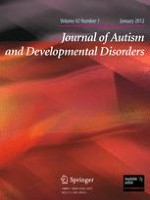01-01-2012 | Original Paper
Estimation of the Intelligence Quotient Using Wechsler Intelligence Scales in Children and Adolescents with Asperger Syndrome
Gepubliceerd in: Journal of Autism and Developmental Disorders | Uitgave 1/2012
Log in om toegang te krijgenAbstract
Asperger syndrome (AS) patients show heterogeneous intelligence profiles and the validity of short forms for estimating intelligence has rarely been studied in this population. We analyzed the validity of Wechsler Intelligence Scale (WIS) short forms for estimating full-scale intelligence quotient (FSIQ) and assessing intelligence profiles in 29 AS patients. Only the Information and Block Design dyad meets the study criteria. No statistically significant differences were found between dyad scores and FSIQ scores (t(28) = 1.757; p = 0.09). The dyad has a high correlation with FSIQ, good percentage of variance explained (R
2 = 0.591; p < 0.001), and high consistency with the FSIQ classification (χ
2(36) = 45.202; p = 0.14). Short forms with good predictive accuracy may not be accurate in clinical groups with atypical cognitive profiles such as AS patients.
